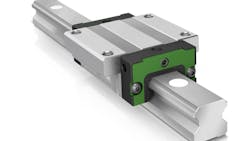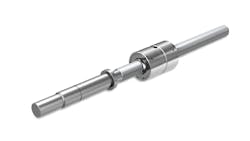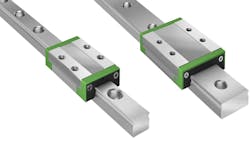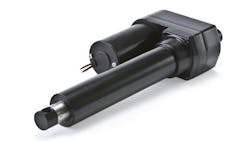Schaeffler Expands Line of Linear Motion Products for Industrial Automation
Motion technology company Schaeffler continues to expand its line of linear motion products — including electromechanical actuators, guides and screws — to meet the needs of various industrial automation applications.
Automation is increasing in food production, packaging and other industrial applications to help maintain productivity, overcome labor shortages as well as reduce costs. This requires the use of linear motion technology which can provide the precision and efficiency desired in automated systems and machines.
As part of its product line expansion, Schaeffler has added electromechanical actuators and guides from Ewellix — which it acquired in 2023 — to its portfolio, helping create one large linear motion company said Thomas Lotz, Schaeffler Americas Vice President for Linear Motion. This enables the company to offer just about any linear motion technology a customer may need to aid the creation of an automated system or machine.
In this interview with Power & Motion, Lotz discusses the expansion of Schaeffler’s linear motion lineup as well as the growing use of electromechanical actuators and the trends he sees driving future developments.
*Editor’s Note: Questions and responses have been edited for clarity.
Power & Motion: Schaeffler is expanding its line of linear motion products and electromechanical actuators. Could you talk about how the company is doing so and what, if any, new products are being added to the lineup?
Thomas Lotz: Schaeffler has added the Ewellix line of electromechanical actuators and linear guides to the portfolio, so now we are one big linear motion company, Schaeffler linear motion. The goal is to have a more complete range of linear motion components. The key components that Schaeffler linear motion offers now are electromechanical actuators, linear guides of various configurations, and also ball and roller screws. Anything related to linear motion driving, actuation and guiding is available now in the range.
If we focus on these different product ranges, the Ewellix rod style actuators are now part of the portfolio. We have rod style actuator lifting columns that are complementing the Schaeffler range of rod less actuators. There's also a larger range of ball and roller screws now available, so roller screws and ball screws that are also manufactured in North America and can be supplied to the customers locally. And then on the linear guide side, Schaeffler already has a very large range, but this range is getting expanded by a few different configurations; in particular, one product that we're launching at Automate in Detroit in May, is a miniature profile rail guide KUEM and also an X arrangement profile rail guide, the KLLT. Those are the key new products that we're launching under this Schaeffler linear motion brand. On top of that, we'll also be showing the full range of actuators and screws that we have to offer [at Automate].
Power & Motion: What prompted the development of the new linear guide products as well as the overall expansion and bringing together of the Schaeffler and Ewellix technologies?
Thomas Lotz: Industrial automation applications are extremely broad – factory automation inside of plants, food automation, medical...there's just such a broad range that the market requires a very broad range of solutions. If we think about a linear motion system, it always consists of a driving component, which could be a ball screw or a roller screw, and a guiding component. The guiding component could be a shaft, a profile rail, rollers or sliding elements. So Schaeffler is now able to offer a much wider range, and the goal is really to be able to provide a wide range of products to the market so that we can serve market needs in industrial applications.
Power & Motion: What are some of the features customers are looking for from their linear motion and/or electromechanical actuator products?
Thomas Lotz: The key features vary depending on application but one of the key features in my view is always repeatability and reliability. The customer wants to have a product that works and that doesn't fail. And then if we think about precision requirements, that really depends. There are applications out there that don't require precision, they just need to move something from A to B and it's okay if it’s off by a couple of millimeters. It doesn't need to be that precise, the cost needs to be low, [and] the control requirements are generally low. But in other applications, the precision requirements might be very high. So, usually if you need precision down to a micron level, that requires more complex motor systems, servo motors, control systems, and so on. All of that affects the overall system [design].
When it comes to actuators, motors and sensor technologies used, that can have a big effect [on design as well]. Because we have a wide range of different products and options, we developed years ago a modular product range around actuating. It's like a Lego box, where if someone needs an actuator to be customized or optimized for a specific application, they can pick from that wide range of options — and these options are expanding day by day — and they can configure something depending on the need that they have. They can pick a gearbox, they can pick a belt adapter, they can pick a direct drive, they can have different motor adapters to put on different screws depending on the force and the power density that is needed. Overall, it's a very modular system that can really customize an actuator to a specific application in a very short amount of time. This is something that we're offering, and also showing at Automate, to deliver a customized actuator without really requiring a newly engineered product every time.
Power & Motion: Is that the kind of solution you’re seeing customers look for more these days and is that helping them get their machines and systems into the market faster?
Thomas Lotz: Usually with electromechanical actuators there’s no one size fits all. Everybody’s got a specific requirement and going for one size fits all means making compromises in a lot of things. What Schaeffler offers is that we have a lot of engineers and part of our value add is we work with customers with application engineering, and we basically customize the solution for them. It doesn’t mean we’re designing a new actuator but we’re customizing what we have to make it fit perfectly within the application and that way the customer gets a better product that better meets their needs.
Power & Motion: You were saying before that the linear motion products and electromechanical actuators are used in a lot of different applications. Are there particular industrial automation applications where they are best suited or you’re seeing them being used more frequently at the moment, or is it pretty widespread?
Thomas Lotz: It’s pretty widespread. There's obviously a big macro trend with more automation happening in a huge range of industries. We see it in construction equipment, agriculture equipment, in factory environments, this is the obvious one, but also in food industries and so on. It is linked to labor shortages and cost reductions. This is a big macro trend that is going to continue.
There is a big need to automate certain functions and automate certain applications. And sometimes it is [part of an] application that is automated, and in some cases it is completely automated. But the more automation happens, the more also precise control is needed and usually with electromechanical actuators you can position them very well. I'm comparing them, for example, to fluid power; the controllability and the positioning performance is a lot better. And from that perspective, we see that these are the key requirements that are driving continued use of electromechanical actuators.
People talk about AI and robotics; AI is everywhere, everybody talks about AI but nobody knows what it does…but AI is the brains behind implementing a lot of artificial intelligence (AI) in different systems. But if you think about what actually does the motion in the background, something's got to move and in robotics something's got to move, so the components that are actually moving the systems that are being controlled by AI, those are the applications where the linear motion components and systems are installed. AI is driving automation, but the motion has to happen somehow, and that motion is coming from these linear systems.
Power & Motion: Since you touched on it, are you seeing electromechanical actuators or other linear motion products being used in place of hydraulics and/or pneumatics now in industrial automation applications? How do you see that continuing to trend?
Thomas Lotz: Definitely we see that. But it depends, again, on the application and the need. Often if there's a system, machine or factory environment that has a lot of pneumatic lines and a certain additional access is required, it's obviously easier and simpler to just install an additional cylinder. The cost is lower; the control system and everything is already there. The benefits of electromechanics are usually the precision and controllability. The other aspect is also that a lot of these electromechanical actuators are virtually maintenance free over their lifetime. There could be benefits in terms of total cost of ownership (TCO), looking at the life cycle of the machine, and there could be benefits in terms of positioning to improve the performance and the output of the machine. Those are benefits that are sometimes obvious, and there's a clear value proposition, to install [electromechanical actuators] and sometimes there's a need to continue with what is there.
Download our eBook "The Shift from Fluid Power to Electromechanical Technologies" for further insights on why some applications are shifting from hydraulics and pneumatics to electromechanical solutions as well as tips on determining the best option for a given application.
What we do see is that the efficiency of electromechanical actuators is higher. There's a lot of companies trying to reduce carbon emissions, reduce energy usage and save costs by investing in that technology [electromechanical actuators] to improve overall efficiency and reduce energy consumption. What we see often is certain applications that require maybe one or two functions that are far away from an existing pneumatic power line or an existing hydraulic line; installing all these extra lines is a huge cost factor. In that case, it becomes a lot easier to just put in a power line for an electromechanical actuator. So, it really depends on where it's being used.
We see with a lot of new designs, if someone is developing a new machine, a new setup, or a new feature from scratch, electromechanical actuation is usually the choice because of the benefits in controllability, energy efficiency, maintenance, and TCO. Often in certain industries, take medical and food applications, [there is] the risk of contamination if you have oil, so having kind of a clean room environment with electromechanical actuators is easier to achieve.
Power & Motion: Do you ever see potential opportunities to pair or utilize in tandem the electromechanical and fluid power technologies to create hybrid systems?
Thomas Lotz: I think it's possible. I think it depends on the complexity of the system and how the system is designed, especially the control systems and how they work together. That's something every engineer needs to consider.
Power & Motion: To help wrap up our conversation, how do you see linear motion and electromechanical actuator technology continuing to evolve in the coming years?
Thomas Lotz: We need to stay on our toes…and make sure that we adapt to the big macro trends that are happening. There is definitely a trend to improve or increase the power density of actuators in the same footprint…and provide more output, more lifetime, more performance, more accuracy; so more for less. At the same time, we see also that in certain applications the cost is coming down with more usage of electromechanical actuators in the hydraulics space. We see the cost of actuators and actuator designs is also partially coming down, the cost of motors is coming down; in the long term, we believe that with the volume adoption of this technology, we will see more and more [electromechanical] actuators being used instead of hydraulics.
Maybe one interesting [trend] is also humanoid robots. Humanoid robots are the future in some form or another. If you think about those robots, they have a lot of actuators built in, they could be rotary, could be linear, there's a bunch of different technologies, but this is where having a more compact actuator with more power density and higher efficiency [will be important]. Higher efficiency is also a key trend; it will be essential, because these are mobile vehicles. These are mobile robots walking around on a battery. Battery power is limited, and they will have to provide more power for a longer period of time. So, the efficiency, power density, size and the footprint of these actuators are going to be important. That's a key trend that I see in the future.
About the Author
Sara Jensen
Executive Editor, Power & Motion
Sara Jensen is executive editor of Power & Motion, directing expanded coverage into the modern fluid power space, as well as mechatronic and smart technologies. She has over 15 years of publishing experience. Prior to Power & Motion she spent 11 years with a trade publication for engineers of heavy-duty equipment, the last 3 of which were as the editor and brand lead. Over the course of her time in the B2B industry, Sara has gained an extensive knowledge of various heavy-duty equipment industries — including construction, agriculture, mining and on-road trucks —along with the systems and market trends which impact them such as fluid power and electronic motion control technologies.
You can follow Sara and Power & Motion via the following social media handles:
X (formerly Twitter): @TechnlgyEditor and @PowerMotionTech
LinkedIn: @SaraJensen and @Power&Motion
Facebook: @PowerMotionTech

Leaders relevant to this article:





